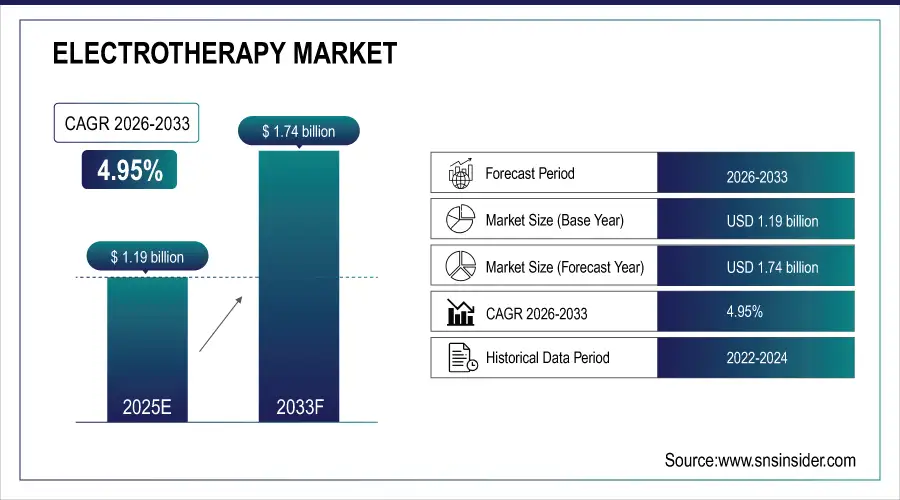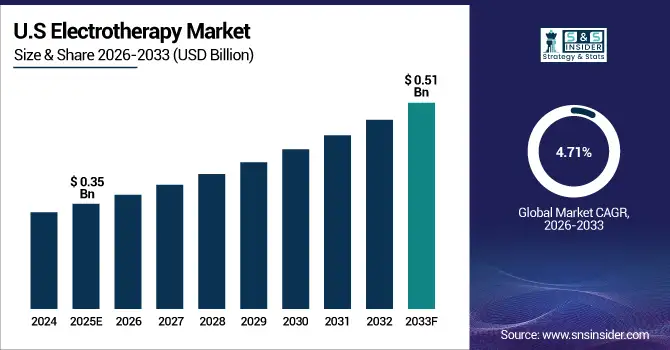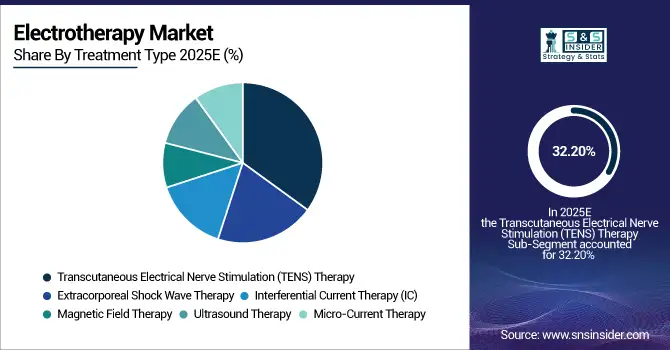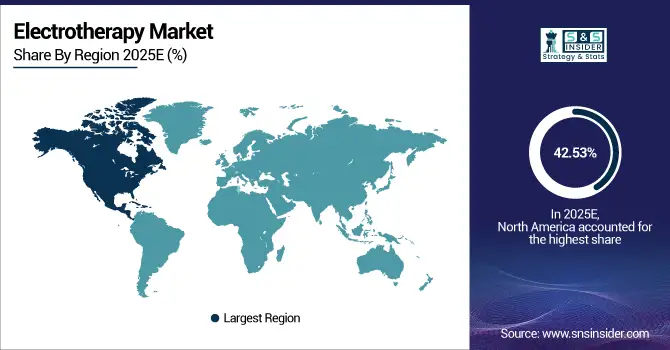Electrotherapy Market Report Scope & Overview:
The Electrotherapy Market size is valued at USD 1.19 Billion in 2025E and is projected to reach USD 1.74 Billion by 2033, growing at a CAGR of 4.95% during 2026-2033.
The Electrotherapy Market analysis highlights the growing adoption of advanced stimulation technologies for pain management, rehabilitation, and musculoskeletal disorders. Increasing prevalence of chronic pain and rising preference for non-invasive treatments are driving market demand.
Over 1.5 billion people globally suffer from chronic pain, with musculoskeletal conditions like back pain and arthritis being the leading causes—fueling demand for non-opioid, non-invasive therapies
Market Size and Forecast:
-
Market Size in 2025E: USD 1.19 Billion
-
Market Size by 2033: USD 1.74 Billion
-
CAGR: 4.95% from 2026 to 2033
-
Base Year: 2025
-
Forecast Period: 2026–2033
-
Historical Data: 2022–2024

To Get more information on Electrotherapy Market - Request Free Sample Report
Electrotherapy Market Trends
-
Growing adoption of wearable and portable electrotherapy devices for home-based pain management and rehabilitation treatments globally.
-
Integration of AI and IoT technologies in electrotherapy devices to improve treatment accuracy, monitoring, and patient outcomes.
-
Rising preference for non-invasive and drug-free pain management therapies among patients with chronic musculoskeletal and neurological conditions.
-
Increasing use of electrotherapy in sports medicine and physiotherapy for faster recovery and muscle stimulation applications.
-
Expanding reimbursement coverage and clinical acceptance of electrotherapy devices across hospitals, clinics, and rehabilitation centers worldwide.
The U.S. Electrotherapy Market size is valued at USD 0.35 Billion in 2025E and is projected to reach USD 0.51 Billion by 2033, growing at a CAGR of 4.71% during 2026-2033. Electrotherapy Market growth is driven by increasing cases of chronic pain, sports injuries, and neurological disorders. High healthcare spending and advanced physiotherapy infrastructure support market expansion. Adoption of wearable and portable electrotherapy devices is rising among patients and professionals.

Electrotherapy Market Growth Drivers:
-
Rising Demand for Non-Invasive Pain Management and Rehabilitation Therapies Across Healthcare Settings
The growing prevalence of chronic pain, arthritis, and musculoskeletal disorders has increased the adoption of electrotherapy as a non-invasive treatment alternative. Patients and healthcare professionals prefer drug-free pain management options to avoid side effects associated with medication. Moreover, technological innovations in TENS and EMS devices are enhancing therapeutic efficiency and user convenience. The rising number of physiotherapy centers and home-use devices is further driving global market expansion.
Over 57% of adults aged 65+ suffer from arthritis or chronic musculoskeletal pain, making them prime candidates for non-invasive electrotherapy interventions
Electrotherapy Market Restraints:
-
Lack of Clinical Evidence and High Equipment Costs Hindering Widespread Adoption
Despite proven benefits, the electrotherapy market faces challenges due to limited large-scale clinical studies validating long-term treatment efficacy. Some patients report inconsistent results, leading to skepticism among healthcare providers. Additionally, the high initial cost of advanced electrotherapy equipment and maintenance expenses restrict adoption in low- and middle-income regions. Inadequate reimbursement coverage and lack of trained professionals also create barriers, particularly in developing healthcare systems with limited technological penetration.
Electrotherapy Market Opportunities:
-
Integration of AI and Wearable Technologies to Enhance Personalized Electrotherapy Solutions
The emergence of AI-driven and IoT-enabled electrotherapy devices presents significant growth opportunities for manufacturers. These technologies enable personalized treatment programs, real-time monitoring, and improved therapeutic outcomes. Growing consumer interest in home-based pain management solutions supports the adoption of compact, wireless devices. Moreover, expanding telehealth infrastructure and digital physiotherapy platforms are expected to boost the accessibility and affordability of electrotherapy treatments worldwide.
In 2025, over 45% of new electrotherapy devices integrated AI algorithms to auto-adjust stimulation intensity based on user feedback and biometric data, improving pain relief consistency
Electrotherapy Market Segment Analysis
-
By Treatment Type, Transcutaneous Electrical Nerve Stimulation (TENS) Therapy led the market with a 32.20% share in 2025, while Magnetic Field Therapy is projected to be the fastest-growing segment with a CAGR of 9.15%.
-
By Application, Pain Management dominated the market, accounting for 30.80% in 2025, whereas Neuromuscular Dysfunction is expected to witness the fastest growth at a CAGR of 8.50%.
-
By End-User, Hospitals led with a 45.61% share in 2025, while Rehabilitation Centers are anticipated to grow fastest at a CAGR of 7.50%.
-
By Device Type, Transcutaneous Electrical Neural Stimulation (TENS) accounted for the largest share of 35.17% in 2025, with Interferential Stimulator (IF) emerging as the fastest-growing device category, registering a CAGR of 8.54%.
By Treatment Type, Transcutaneous Electrical Nerve Stimulation (TENS) Therapy Leads Market While Magnetic Field Therapy Registers Fastest Growth
Transcutaneous Electrical Nerve Stimulation (TENS) therapy dominates the electrotherapy market due to its proven effectiveness in pain management and muscle rehabilitation. Widely used in hospitals, clinics, and home-care settings, TENS devices offer non-invasive and drug-free relief for chronic and acute pain conditions. Meanwhile, Magnetic Field Therapy is witnessing rapid growth driven by increasing research in cellular regeneration, sports injury recovery, and chronic fatigue treatment. Its expanding adoption across physiotherapy and wellness centers further contributes to segment growth globally.

By Application, Pain Management Dominate While Neuromuscular Dysfunction Shows Rapid Growth
Pain management remains the largest application area within the electrotherapy market, supported by a surge in chronic pain conditions like arthritis, neuropathy, and post-surgical discomfort. The demand for non-pharmacological and long-term pain relief has encouraged the use of advanced electrotherapy devices across healthcare settings. While, neuromuscular dysfunction are growing rapidly due to rising awareness of rehabilitation benefits in neurological disorders such as stroke, spinal cord injuries, and multiple sclerosis. Enhanced device precision and therapy customization further propel this segment’s expansion.
By End-User, Hospital Lead While Rehabilitation Centers Registers Fastest Growth
Hospitals hold the leading market share in the electrotherapy sector owing to widespread integration of advanced therapeutic devices for pain management, neuromuscular re-education, and postoperative rehabilitation. These facilities often serve as primary centers for chronic and acute pain treatment. However, rehabilitation centers are projected to witness the fastest growth as patient preference shifts toward personalized, long-duration therapy programs. The increasing number of physiotherapy and wellness centers globally, coupled with the rising elderly population requiring mobility restoration, supports this trend significantly.
By Device Type, Transcutaneous Electrical Neural Stimulation (TENS) Lead While Interferential Stimulator (IF) Grow Fastest
Transcutaneous Electrical Neural Stimulation (TENS) devices lead the electrotherapy market due to their versatility, affordability, and widespread clinical acceptance for pain relief. Portable TENS units are increasingly popular for home use, expanding accessibility and convenience. Meanwhile, Interferential Stimulators (IF) are expected to grow at the fastest rate as clinicians recognize their superior deep tissue stimulation and pain modulation capabilities. Continuous technological innovations improving device portability, user comfort, and treatment precision are further boosting the growth of this segment across medical and wellness applications.
Electrotherapy Market Regional Analysis:
North America Electrotherapy Market Insights
In 2025 North America dominated the Electrotherapy Market and accounted for 42.53% of revenue share, this leadership is due to the advanced healthcare systems, strong regulatory frameworks, and early adoption of innovative therapeutic devices. The region benefits from high prevalence of chronic pain and sports injuries. Extensive R&D investments by major companies enhance device efficacy and user comfort. Increasing demand for wearable and home-based electrotherapy solutions continues to fuel market growth.

Get Customized Report as per Your Business Requirement - Enquiry Now
U.S. Electrotherapy Market Insights
The U.S. dominates the North American electrotherapy market, driven by technological innovation, high patient awareness, and access to advanced physiotherapy treatments. Growing adoption of TENS and EMS devices in homecare settings supports expansion. Rising incidence of back pain, arthritis, and postoperative discomfort increases demand.
Asia-pacific Electrotherapy Market Insights
Asia-pacific is expected to witness the fastest growth in the Electrotherapy Market over 2026-2033, with a projected CAGR of 5.52% due to growing healthcare infrastructure and rising incidence of musculoskeletal and neurological disorders. Increasing awareness of non-invasive pain management and government healthcare initiatives support adoption. Countries like China, India, Japan, and South Korea are key contributors. The region also benefits from affordable device manufacturing and expanding physiotherapy centers.
China Electrotherapy Market Insights
China represents one of the fastest-growing electrotherapy markets in Asia, fueled by increasing healthcare investments and expanding rehabilitation centers. The government’s emphasis on elderly care and chronic pain management supports strong domestic demand.
Europe Electrotherapy Market Insights
Europe’s electrotherapy market shows steady growth, supported by well-established physiotherapy infrastructure and increasing focus on rehabilitation medicine. Rising prevalence of chronic pain and sports injuries has accelerated the demand for advanced electrotherapy devices. Countries like the Germany, UK, France, and Italy are key contributors. Government healthcare initiatives and aging populations further support adoption. The market also benefits from favorable reimbursement policies and strong manufacturer presence in medical technology sectors.
Germany Electrotherapy Market Insights
Germany holds a leading position in the European electrotherapy market owing to its advanced healthcare infrastructure and growing emphasis on physical rehabilitation. High awareness of non-invasive pain treatments drives steady adoption across hospitals and clinics.
Latin America (LATAM) and Middle East & Africa (MEA) Electrotherapy Market Insights
The Electrotherapy Market is experiencing moderate growth in the Latin America (LATAM) and Middle East & Africa (MEA) regions, due to the improving healthcare access and rising awareness of physiotherapy benefits. Countries like Brazil, Mexico, and the UAE are key emerging markets. Increasing government efforts to modernize rehabilitation services and import advanced medical devices are supporting expansion.
Electrotherapy Market Competitive Landscape:
Medtronic PLC is a global leader in medical technology, offering a broad electrotherapy product portfolio for pain management and neuromuscular stimulation. The company’s advanced neurostimulation devices are widely used in hospitals and rehabilitation centers. Strong R&D investments support innovation in implantable and wearable technologies. Medtronic’s global distribution network ensures accessibility across developed and emerging markets.
-
In March 2024, Medtronic inaugurated its expanded Engineering and Innovation Centre in Hyderabad, India, aiming to boost R&D capacity by 900 engineers and invest around ₹3,000 crore over five years.
Alimed Inc. specializes in supplying medical and rehabilitation products, including a wide range of electrotherapy and therapeutic devices. The company caters to hospitals, clinics, and homecare settings, focusing on improving patient comfort and recovery outcomes. Its electrotherapy solutions support pain management, muscle re-education, and physical rehabilitation. Alimed’s customer-centric approach and extensive product catalog strengthen its position in the healthcare supply market.
-
In September 2024, Alimed secured a nationwide contract with Vizient to supply radiation-protection products with negotiated pricing and “same-day” shipping for the health-system's member institutions.
Cogentix Medical Inc. develops and markets medical devices focused on urology and pain management, including neuromodulation-based electrotherapy solutions. Its products are designed to provide minimally invasive treatment options for chronic conditions such as urinary incontinence and pelvic pain. The company emphasizes innovation in non-surgical therapeutic technologies. Strategic acquisitions and product portfolio expansion have strengthened its global presence.
-
In January 2025, Bausch + Lomb acquired Whitecap Biosciences LLC, adding its glaucoma and geographic-atrophy therapeutic pipeline (including drug candidate WB007) to boost its clinical-stage R&D efforts.
Electrotherapy Market Key Players:
Some of the Electrotherapy Market Companies are:
-
Orbotech Ltd.
-
Screen Holdings Co., Ltd.
-
Mitsubishi Electric Corporation
-
Hitachi High-Technologies Corporation
-
Manz AG
-
Limata GmbH
-
First EIE SA
-
Miva Technologies GmbH
-
LPKF Laser & Electronics AG
-
Altix Automation SA
-
Koh Young Technology Inc.
-
Schmoll Maschinen GmbH
-
Ucamco NV
-
Atg Luther & Maelzer GmbH
-
Fujifilm Corporation
-
Agfa-Gevaert Group
-
Aiscent Technologies
-
Han’s Laser Technology Industry Group Co., Ltd.
-
CIMS China
-
Canon Inc.
| Report Attributes | Details |
|---|---|
| Market Size in 2025E | USD 1.19 Billion |
| Market Size by 2033 | USD 1.74 Billion |
| CAGR | CAGR of 4.95% From 2026 to 2033 |
| Base Year | 2025E |
| Forecast Period | 2026-2033 |
| Historical Data | 2022-2024 |
| Report Scope & Coverage | Market Size, Segments Analysis, Competitive Landscape, Regional Analysis, DROC & SWOT Analysis, Forecast Outlook |
| Key Segments | • By Treatment Type (Extracorporeal Shock Wave Therapy, Interferential Current Therapy (IC), Magnetic Field Therapy, Ultrasound Therapy, Transcutaneous Electrical Nerve Stimulation (TENS) Therapy, and Micro-Current Therapy), • By Application (Pain Management, Anxiety and Insomnia Management, Sports Medicine, Neuromuscular Dysfunction, Urine and Fecal Incontinence, Iontophoresis, Orthopedics, Cardiology, and Others), • By End-User (Hospital, Clinics, Rehabilitation Centers, Long Term Centers, and Others), • By Device Type (Transcutaneous Electrical Neural Stimulation (TENS), Electronic Muscle Stimulator (EMS), Interferential Stimulator (IF), High Voltage Pulsed Galvanic Stimulator (HVPGS), and Others). |
| Regional Analysis/Coverage | North America (US, Canada), Europe (Germany, UK, France, Italy, Spain, Russia, Poland, Rest of Europe), Asia Pacific (China, India, Japan, South Korea, Australia, ASEAN Countries, Rest of Asia Pacific), Middle East & Africa (UAE, Saudi Arabia, Qatar, South Africa, Rest of Middle East & Africa), Latin America (Brazil, Argentina, Mexico, Colombia, Rest of Latin America). |
| Company Profiles | Medtronic PLC, Alimed Inc., St. Jude Medical Inc., Cogentix Medical Inc., Zynex Medical, Neurometrix Inc., DJO Global Inc., Cyberonics Inc., Nevro Corp., Boston Scientific Corporation, Omron Healthcare Inc., BioMedical Life Systems Inc., EMS Physio Ltd., BTL Industries, Enraf-Nonius BV, Chattanooga Group, Ito Co. Ltd., Beurer GmbH, Sirona Medical Technologies, GZ Longest Science & Technology Co. Ltd. |

